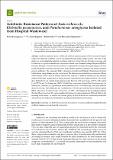| dc.contributor.author | Karungamy, Petro | |
| dc.contributor.author | Rugaika, Anita | |
| dc.contributor.author | Mte, Kelvin | |
| dc.contributor.author | Machunda, Revocatus | |
| dc.date.accessioned | 2023-09-19T12:41:21Z | |
| dc.date.available | 2023-09-19T12:41:21Z | |
| dc.date.issued | 2023-07-08 | |
| dc.identifier.uri | https://doi.org/10.3390/applmicrobiol3030060 | |
| dc.identifier.uri | https://dspace.nm-aist.ac.tz/handle/20.500.12479/2029 | |
| dc.description | This research article was published by Applied Microbiology in 2023 | en_US |
| dc.description.abstract | Antibiotic-resistant bacteria (ARB) and antibiotic resistance genes (ARGs) in treated hospital wastewater effluents constitute a major environmental and public health concern. The aim of this study was to investigate the antibiotic resistance patterns of Escherichia coli, Klebsiella pneumoniae, and Pseudomonas aeruginosa isolated from wastewater effluent at the Benjamin Mkapa Hospital (BMH) in Dodoma, Tanzania. These bacteria were selected to represent the most prevalent gram-negative bacteria found in hospital wastewater, and they have the potential to generate resistance and spread resistance genes to antibiotics. The wastewater BMH is treated in a Constructed Wetland (CW) planted with Typha latifolia before being released into the environment. The bacteria were isolated from wastewater effluent collected at the outlet of the CW. Isolated bacteria were analyzed for antibiotic resistance by disc diffusion method. Molecular identification of bacterial species was performed by using 16S rRNA. The results show that Klebsiella ssp. was the most common isolate detected, with a prevalence of 39.3%, followed by E. coli (27.9%) and Pseudomonas ssp. (18.0%). Klebsiella ssp. were more resistant than Pseudomonas ssp. for Tetracycline, Gentamycin, Ciprofloxacin, and Sulfamethoxazole. Pseudomonas ssp. were more resistant than Klebsiella ssp. for Ceftriaxone and Azithromycin. Klebsiella ssp. harbored more resistance genes (40%), followed by Pseudomonas ssp. (35%) and E. coli (20%). The findings of this investigation indicate that the effluent from the CW requires additional treatment to reduce discharged ARB and ARGs in the receiving water bodies. As a result, the effluent quality of the CW should be continuously monitored and assessed, and further developments for treating the final effluent are necessary. | en_US |
| dc.language.iso | en | en_US |
| dc.publisher | Applied Microbiology | en_US |
| dc.subject | Escherichia coli | en_US |
| dc.subject | Klebsiella pneumoniae | en_US |
| dc.subject | Pseudomonas aeruginosa | en_US |
| dc.subject | Antibiotic-resistant bacteria | en_US |
| dc.subject | Antibiotic resistance genes | en_US |
| dc.subject | Hospital wastewater | en_US |
| dc.title | Antibiotic Resistance Patterns of Escherichia coli, Klebsiella pneumoniae, and Pseudomonas aeruginosa Isolated from Hospital Wastewater | en_US |
| dc.type | Article | en_US |

